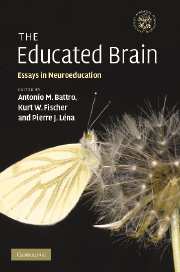Book contents
- Frontmatter
- Contents
- List of figures
- List of tables
- List of contributors
- Preface
- Foreword: Towards a new pedagogical and didactic approach
- Part I The mind, brain, and education triad
- Part II Brain development, cognition, and education
- Part III Brain, language, and mathematics
- 11 A triptych of the reading brain: Evolution, development, pathology, and its intervention
- 12 Reading and the brain: A cross-language approach
- 13 Cortical images of early language and phonetic development using near infrared spectroscopy
- 14 Cerebral constraints in reading and arithmetic: Education as a “neuronal recycling” process
- Index
- References
12 - Reading and the brain: A cross-language approach
from Part III - Brain, language, and mathematics
Published online by Cambridge University Press: 22 September 2009
- Frontmatter
- Contents
- List of figures
- List of tables
- List of contributors
- Preface
- Foreword: Towards a new pedagogical and didactic approach
- Part I The mind, brain, and education triad
- Part II Brain development, cognition, and education
- Part III Brain, language, and mathematics
- 11 A triptych of the reading brain: Evolution, development, pathology, and its intervention
- 12 Reading and the brain: A cross-language approach
- 13 Cortical images of early language and phonetic development using near infrared spectroscopy
- 14 Cerebral constraints in reading and arithmetic: Education as a “neuronal recycling” process
- Index
- References
Summary
Overview
The learning of reading skills is causally related to some properties of the language itself. Transparent or consistent alphabetic languages, such as Spanish, map most easily from orthography to sounds, with one-to-one correspondence from letters to phonemes. Inconsistent orthographies, such as English, show instead a greater mismatch between orthography and phonology. A pre-reading child detects small units within syllables in his spoken vocabulary, units comprised of onset and rime. Analyzing speech into these components is central to phonological awareness, the ability to analyze speech into its component sounds. Reading in an alphabetic language requires relating letters to sound units that are smaller than onset and rime, units called phonemes. Goswami argues that children learn phonemes through mastering the orthography (letters in combination) of their language. To master the code relating written letters to spoken sounds, children need more time for languages with inconsistent orthography, even when they do not have dyslexia. Dyslexic children of all languages have greater trouble learning letter-sound relationships, typically because of poor representation of sounds, which can be investigated in both behavior and brain imaging. Electrical potentials from cortical activity evoked by sounds and other stimuli indicate that the auditory systems of dyslexic children seem to be more immature than those of normal children. This kind of research combining both behavior and brain activity to analyze reading is one of the areas that is most likely to produce important knowledge relevant for schooling in the near future.
The Editors
Information
- Type
- Chapter
- Information
- The Educated BrainEssays in Neuroeducation, pp. 198 - 212Publisher: Cambridge University PressPrint publication year: 2008
References
Accessibility standard: Unknown
Why this information is here
This section outlines the accessibility features of this content - including support for screen readers, full keyboard navigation and high-contrast display options. This may not be relevant for you.Accessibility Information
- 1
- Cited by
